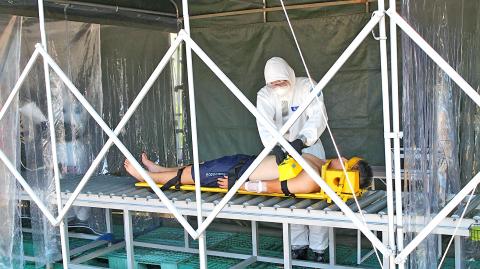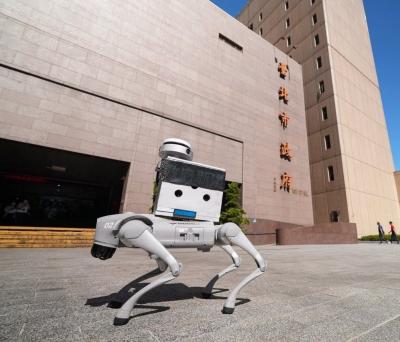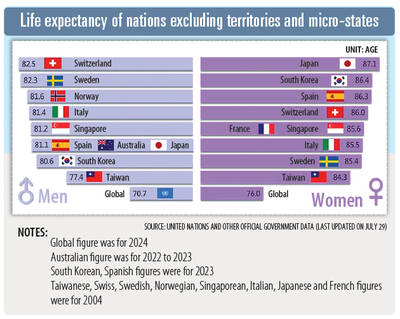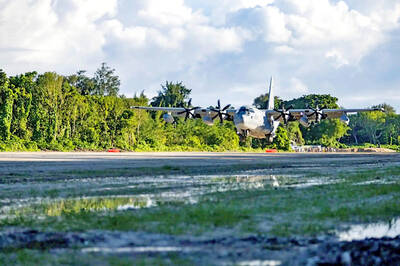The Atomic Energy Council (AEC) yesterday concluded the nation’s largest-ever nuclear safety drill in areas surrounding the Jinshan Nuclear Power Plant in New Taipei City’s Shihmen District (石門), which included a practice evacuation of about 4,000 residents and emergency disaster response drills by the armed forces.
The scenario of the three-day drill assumed that the plant was devastated by days of torrential rain and a magnitude 6.5 earthquake that caused power and water outages, and a breakdown of the plant’s cooling system, leading to reactor overheating and a hydrogen-air explosion to damage the containment buildings and emit radioactive materials, the AEC said.
However, Department of Nuclear Technology director Hsu Ming-te (徐明德) said that such a scenario is unlikely, as the plant is equipped with at least two backup diesel generators and a water pool to avoid power and water outages, and the plant director is authorized to release a buildup of hydrogen to avoid an explosion.

Photo: Huang Chieh, Taipei Times
According to the AEC’s response mechanism, residents living within an 8km radius of the plant have to be evacuated within three days of a nuclear accident, as the plant, since the 2011 Fukushima Dai-ichi nuclear disaster in Japan, is able to operate for 72 hours without external power and water supply, so a reactor meltdown and radiation leakage would only occur three days after an accident, Hsu said.
Nearly 4,000 people, or about 13 percent of people living in the area, were moved to shelters during the evacuation exercise yesterday, the AEC said.
Students at Lao Mai Elementary School and Shimen Junior High School in Shihmen were among the first to be evacuated, as children and young students are especially sensitive to radiation due to underdeveloped thyroid glands, the AEC said.
About 1,800 residents were moved to the Sinjhuang Gymnasium in New Taipei City, which could temporarily accommodate up to 4,000 people in the event of a nuclear disaster, the AEC said, adding that there are about 10 such facilities in the city that could be turned into shelters in the event of a disaster.
Responders in radiation protection suits stood guard at main arterial roads connected to the affected areas in a drill to inspect and decontaminate vehicles and those being evacuated, as well as keep radioactively contaminated patients under quarantine.
The army, air force and coast guard showcased radiation detection carriers to conduct radioactivity tests on land, sea and air, with the data collected to be instantaneously submitted to the AEC headquarters.
Asked about post-evacuation measures, New Taipei City Deputy Mayor Hou You-yi (侯友宜) said that environmental remediation and decontamination would be performed in affected areas after people are removed, adding that those evacuated could return only after radiation returns to background levels.
On Tuesday, the AEC and Taiwan Power Co (Taipower) simulated the repair of nuclear reactors, and the operation of a backup power supply system and emergency water sourcing, as well as the transportation of disaster response officials and machinery from the Guosheng Nuclear Power Plant in New Taipei City’s Wanli District (萬里) by helicopter.
The drill also saw members of Taipower’s repair crew transferred to Taipei Veterans General Hospital to be treated in a quarantine ward for radiation contamination and injuries.

The inspection equipment and data transmission system for new robotic dogs that Taipei is planning to use for sidewalk patrols were developed by a Taiwanese company, the city’s New Construction Office said today, dismissing concerns that the China-made robots could pose a security risk. The city is bringing in smart robotic dogs to help with sidewalk inspections, Taipei Deputy Mayor Lee Ssu-chuan (李四川) said on Facebook. Equipped with a panoramic surveillance system, the robots would be able to automatically flag problems and easily navigate narrow sidewalks, making inspections faster and more accurate, Lee said. By collecting more accurate data, they would help Taipei

STATS: Taiwan’s average life expectancy of 80.77 years was lower than that of Japan, Singapore and South Korea, but higher than in China, Malaysia and Indonesia Taiwan’s average life expectancy last year increased to 80.77 years, but was still not back to its pre-COVID-19 pandemic peak of 81.32 years in 2020, the Ministry of the Interior said yesterday. The average life expectancy last year increased the 0.54 years from 2023, the ministry said in a statement. For men and women, the average life expectancy last year was 77.42 years and 84.30 years respectively, up 0.48 years and 0.56 years from the previous year. Taiwan’s average life expectancy peaked at 81.32 years in 2020, as the nation was relatively unaffected by the pandemic that year. The metric

TAKING STOCK: The USMC is rebuilding a once-abandoned airfield in Palau to support large-scale ground operations as China’s missile range grows, Naval News reported The US Marine Corps (USMC) is considering new sites for stockpiling equipment in the West Pacific to harden military supply chains and enhance mobility across the Indo-Pacific region, US-based Naval News reported on Saturday. The proposed sites in Palau — one of Taiwan’s diplomatic allies — and Australia would enable a “rapid standup of stored equipment within a year” of the program’s approval, the report said, citing documents published by the USMC last month. In Palau, the service is rebuilding a formerly abandoned World War II-era airfield and establishing ancillary structures to support large-scale ground operations “as China’s missile range and magazine

Passengers on Taiwan High Speed Rail (THSR) will be required to use headphones and make phone calls in gangways under new “quiet travel” rules starting Sept. 22. THSR Chairman Shih Che (史哲) told media that THSR will run a three-month promotional campaign to ensure widespread adoption of the new rules. Those repeatedly ignoring the guidance face the potential termination of their transport contract, which can result in them getting escorted off the train, according to THSR. Shih shared his hope to cultivate an environment conducive to rest and reading for the train’s passengers, stating that these changes aim to “promote self-discipline” among passengers